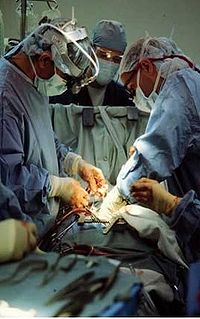
Photo from wikipedia
From the dawn of open-heart surgery in the early 1950s, a sequence of significant scientific achievements rendered cardiac surgery as a routine practice in the treatment of heart diseases. Contemporary… Click to show full abstract
From the dawn of open-heart surgery in the early 1950s, a sequence of significant scientific achievements rendered cardiac surgery as a routine practice in the treatment of heart diseases. Contemporary advances in cardiac surgery including surgical techniques, anaesthesia and intensive care management markedly improved clinical outcomes. However, cardiac surgery is still hampered by considerable morbidity and subsequent mortality, especially in complex and high-risk procedures. As evidenced in the largest cardiac surgery registry (STS database) that incorporates data from over 200,000 procedures, operative results are excellent irrespective of surgical technique in the setting of low-risk elective coronary artery bypass grafting (CABG), isolated aortic valve replacement (AVR) or mitral valve repair (1).
Journal Title: Journal of thoracic disease
Year Published: 2019
Link to full text (if available)
Share on Social Media: Sign Up to like & get
recommendations!